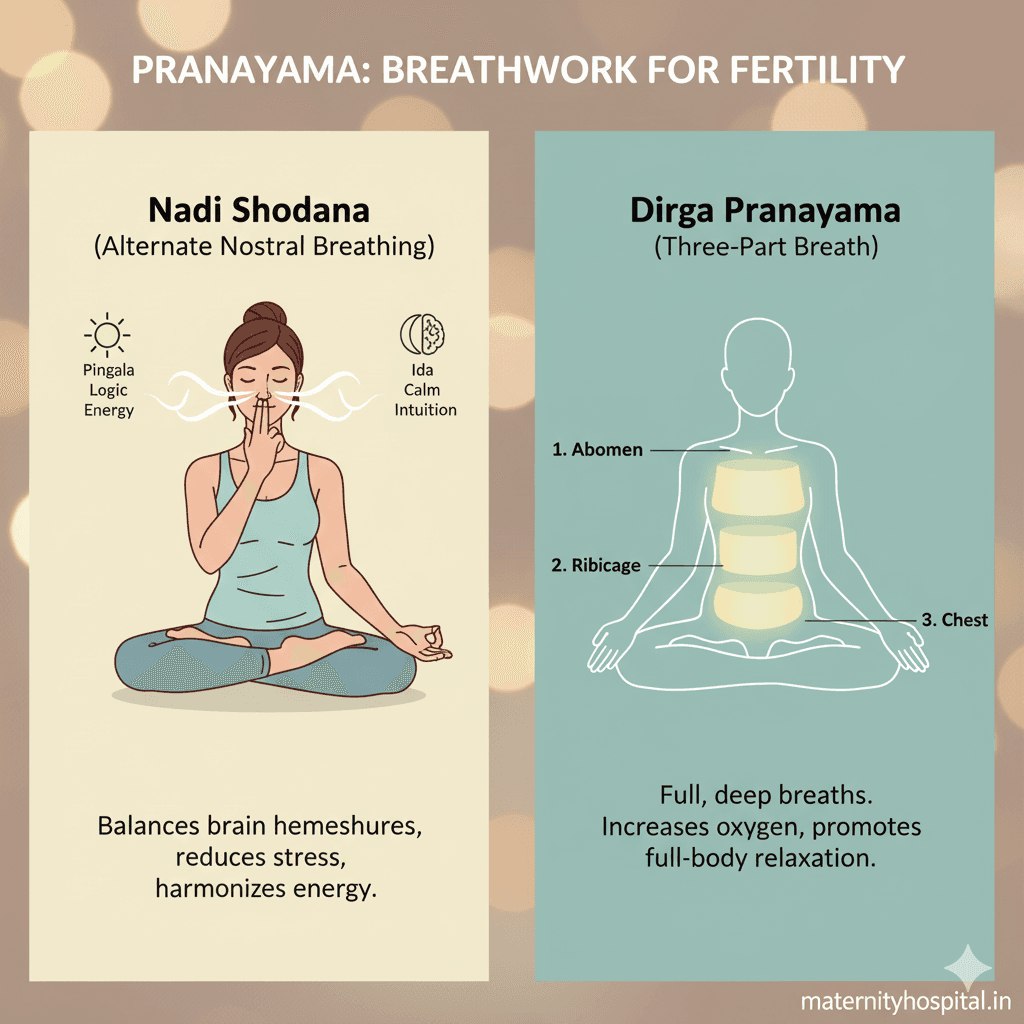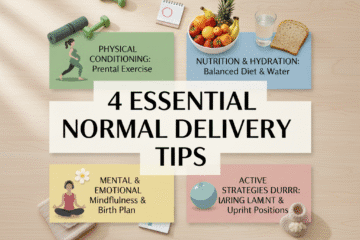
4 Simple Ways to Use Yoga When Trying to Conceive
Introduction – Harmonizing Body and Mind for Conception
The journey of trying to conceive (TTC) is often a blend of hope, meticulous planning, and sometimes, unexpected emotional and physical challenges. While medical interventions and dietary adjustments play a significant role, an increasing number of couples are turning to holistic practices to support their fertility journey. Among these, yoga stands out as a powerful ancient discipline that harmonizes the body, mind, and spirit. It’s more than just physical postures; it’s a comprehensive system that can significantly impact the intricate processes involved in conception. The practice of yoga when trying to conceive offers a gentle yet profound way to prepare the body for pregnancy, manage stress, and cultivate a sense of inner calm crucial for optimal reproductive health.
This article will explore the manifold benefits of incorporating yoga into your preconception routine, delving into how specific poses, breathing techniques (pranayama), and meditation can create a fertile environment. We’ll examine the scientific rationale behind yoga’s positive effects on hormonal balance, stress reduction, and blood flow to the reproductive organs. Furthermore, we will differentiate between beneficial fertility-focused yoga and high-impact exercises that might be counterproductive. By understanding how to mindfully integrate yoga when trying to conceive, you can enhance your chances of conception, foster emotional resilience, and embark on this beautiful journey with a grounded and positive outlook. This holistic approach supports not just the physical act of conceiving, but the entire emotional and spiritual readiness for parenthood.
The Stress-Fertility Connection:How Yoga Breaks the Cycle
One of the most profound ways yoga when trying to conceive supports fertility is by mitigating stress. The link between stress and fertility is well-documented: chronic stress can significantly impact the hormonal balance essential for reproduction. When the body perceives stress, it activates the “fight or flight” response, releasing hormones like cortisol. Elevated cortisol levels can, in turn, suppress the production of gonadotropin-releasing hormone (GnRH), which is critical for stimulating the release of follicle-stimulating hormone (FSH) and luteinizing hormone (LH)—the very hormones that regulate ovulation in women and sperm production in men. This hormonal cascade can lead to irregular cycles, anovulation (absence of ovulation), or poor sperm quality. The emotional toll of TTC itself can create a vicious cycle, where the stress of trying to conceive further exacerbates fertility challenges.
Yoga directly addresses this cycle through its emphasis on mindfulness, breathwork (pranayama), and gentle movement. Practices like diaphragmatic breathing activate the parasympathetic nervous system, shifting the body from a state of stress to one of rest and digest. This shift helps to lower cortisol levels, promote hormonal balance, and improve overall reproductive function. Regular yoga practice teaches the body and mind to respond to stress more effectively, fostering a sense of calm and control. By reducing mental and emotional strain, yoga when trying to conceive creates a more receptive internal environment, allowing the body to prioritize reproductive functions rather than survival responses. It’s about cultivating a peaceful inner landscape that can positively influence the delicate dance of hormones required for successful conception.
Specific Yoga Poses forReproductive Health and Circulation
Beyond stress reduction, certain yoga poses (asanas) are particularly beneficial for improving reproductive health by enhancing blood flow to the pelvic region, stimulating glands, and gently stretching and strengthening relevant muscles. These poses are often categorized under “fertility yoga” and are designed to be gentle and restorative, rather than strenuous. The deliberate movements and sustained holds help to oxygenate reproductive organs, clear energetic blockages, and promote overall vitality.
Key Poses and Their Benefits:
- Bound Angle Pose (Baddha Konasana): This pose gently opens the hips and groin, increasing blood flow to the pelvic area and stretching the inner thighs. It’s calming and can help alleviate tension in the hips, which is often a repository of stress.
- Legs Up the Wall Pose (Viparita Karani): A deeply restorative inversion that helps reduce stress, calms the nervous system, and gently reverses blood flow, bringing fresh circulation to the reproductive organs. It can also help alleviate fatigue.
- Bridge Pose (Setu Bandhasana): This mild inversion gently lifts the hips, promoting circulation to the uterus and ovaries. It also strengthens the back and stretches the chest, opening the body and alleviating fatigue.
- Cobra Pose (Bhujangasana): A gentle backbend that can stimulate the abdominal organs, including the uterus and ovaries. It also helps to strengthen the spine and open the chest.
- Child’s Pose (Balasana): A deeply grounding and calming pose that helps to relieve stress and gently massages the abdominal organs when the torso rests on the thighs.
When practicing yoga when trying to conceive, it’s essential to listen to your body and avoid any poses that cause discomfort. The focus should always be on gentle stretching, deep breathing, and mindful relaxation, rather than intense physical exertion or competitive achievement. Regular, consistent practice of these fertility-enhancing poses can create a more robust and receptive reproductive system.
The Mind-Body Connection:Meditation, Breathwork, and Hormones
The mind-body connection is central to the efficacy of yoga when trying to conceive. It recognizes that our mental and emotional states are not separate from our physical health, particularly when it comes to the intricate hormonal symphony required for conception. Meditation and breathwork (pranayama) are powerful tools within yoga that directly tap into this connection, influencing physiological processes that support fertility.
Meditation and Visualization: Regular meditation practices help to calm the mind, reduce anxiety, and foster a positive outlook. For women TTC, guided meditations focusing on fertility, imagining a healthy conception, or visualizing a peaceful womb environment can be particularly beneficial. While not a guaranteed solution, this practice helps to shift the mindset from fear and worry to hope and acceptance, which can reduce the physiological impact of stress on the reproductive system. Visualization can lower stress hormones and promote a more relaxed state, which is conducive to fertility.
- Pranayama (Breathwork): Specific breathing techniques directly influence the autonomic nervous system.
- Nadi Shodhana (Alternate Nostril Breathing): This technique balances the right and left hemispheres of the brain, promoting emotional equilibrium and reducing stress. It’s believed to harmonize energy flow throughout the body.
- Dirga Pranayama (Three-Part Breath): A calming breath that encourages full, deep breathing, increasing oxygenation and promoting relaxation throughout the entire body.
These practices help regulate the hypothalamic-pituitary-adrenal (HPA) axis, which is the body’s central stress response system. By bringing this system into balance, yoga when trying to conceive can indirectly support the hypothalamic-pituitary-gonadal (HPG) axis, the primary controller of reproductive function. This deeper physiological regulation means that regular meditation and breathwork can contribute to more regular menstrual cycles, improved hormonal profiles, and a more receptive environment for conception, fostering a state of calm readiness.
Differentiating Fertility Yogafrom High-Impact Exercise

While yoga when trying to conceive can be incredibly beneficial, it’s crucial to understand that not all forms of exercise, or even all forms of yoga, are suitable for this sensitive phase. The distinction lies in the intensity and the overall impact on the body, particularly the reproductive system and energy levels. The goal during TTC is to nurture and support, not to deplete or stress the body further.
What to Modify or Avoid:
- High-Impact Workouts: Intense cardio, heavy weightlifting, long-distance running, or high-intensity interval training (HIIT) can place significant stress on the body. While beneficial for general health, these activities can elevate cortisol levels, potentially diverting energy away from reproductive functions and impacting ovulation or implantation. For individuals with low body weight or those already experiencing irregular cycles, high-intensity exercise can exacerbate these issues.
- Hot Yoga (e.g., Bikram): Practices in very hot rooms can lead to overheating and dehydration, which are generally not recommended when trying to conceive or during early pregnancy. The extreme heat can also add unnecessary physiological stress.
- Advanced or Acrobatic Yoga: Intense inversions, deep twists, or physically demanding poses that require significant strength and balance might be too strenuous. The focus should be on gentle, supportive movements rather than pushing physical limits.
Focus on Gentle and Restorative Practices: Fertility yoga emphasizes gentle hatha or restorative styles. These practices prioritize slow movements, longer holds in comfortable positions, and deep relaxation. They focus on opening the hips, stimulating pelvic circulation, and calming the nervous system without undue strain. The aim is to create space and fluidity in the body while promoting a sense of peace and groundedness. Always listen to your body, avoid pain, and consult with a qualified yoga instructor or healthcare provider who understands fertility for personalized guidance on incorporating yoga when trying to conceive. The mantra is “nourish, don’t punish.”
Integrating Yoga into Your TTC Journey:Practical Tips
Successfully integrating yoga when trying to conceive involves mindful planning and consistency. It’s not about adding another item to an already long to-do list, but about creating a nurturing ritual that supports your well-being. Here are practical tips to make yoga a beneficial part of your fertility journey:
- Start Slowly and Gently: If you’re new to yoga, begin with beginner-friendly classes focusing on hatha or restorative styles. Even 15-20 minutes a few times a week can make a difference. Online resources and apps can be excellent starting points.
- Focus on Fertility-Specific Poses: Prioritize poses that open the hips, increase pelvic circulation, and calm the nervous system (as mentioned in Part 3). Examples include Bound Angle Pose, Legs Up the Wall, and gentle backbends.
- Incorporate Breathwork and Meditation: Dedicate time each day (even 5-10 minutes) to deep breathing exercises like Nadi Shodhana or simple guided meditations. This is crucial for stress reduction and hormonal balance. Many free guided meditations are available online.
- Listen to Your Body: This is paramount. Avoid any pose that causes pain or significant discomfort. If you feel tired, opt for restorative poses. If you suspect you might be pregnant (e.g., during the two-week wait), choose gentle, non-abdominal-compressing poses.
- Seek Qualified Guidance: Consider finding a yoga instructor who has experience with fertility or prenatal yoga. They can provide modifications and ensure your practice is safe and effective for your specific needs.
- Consistency Over Intensity: Regular, gentle practice is far more beneficial than sporadic, intense sessions. Make yoga a consistent part of your routine, whether it’s a dedicated class or a short home practice.
- Combine with Other Fertility Support: Yoga is a complementary therapy. It works best when combined with a healthy diet, adequate sleep, medical advice, and other recommended fertility treatments. It supports the whole person, not just isolated symptoms.
By approaching yoga when trying to conceive with intention and gentleness, you can cultivate a sense of peace, resilience, and physical readiness, creating a truly supportive environment for your path to parenthood.
Frequently Asked Questions(FAQs) on yoga when trying to conceive
Q1: How does yoga help with fertility? A: Yoga helps fertility primarily by reducing stress, which can negatively impact hormonal balance crucial for ovulation and conception. It also improves blood circulation to the pelvic organs, promotes relaxation, and can help balance the nervous and endocrine systems, creating a more receptive environment for pregnancy.
Q2: Are there specific yoga poses I should do or avoid when trying to conceive? A: Yes. Focus on gentle, restorative poses that open the hips and increase pelvic blood flow, such as Bound Angle Pose, Legs Up the Wall, and gentle Bridge Pose. Avoid high-impact, strenuous, or excessively hot yoga (like Bikram) that can cause overheating or excessive stress. Listen to your body and avoid any painful poses.
Q3: How often should I practice yoga when trying to conceive? A: Consistency is more important than intensity. Aim for 15-30 minutes of gentle yoga, including breathwork and meditation, three to five times a week. Even short, daily practices can yield significant benefits for stress reduction and well-being.
Q4: Can men also practice yoga to improve fertility? A: Absolutely! Yoga benefits men’s fertility by reducing stress, improving circulation to the reproductive organs, and enhancing overall physical and mental health. Stress reduction is crucial for sperm quality and production. Poses like Bound Angle Pose and Legs Up the Wall can also be beneficial for men.
Q5: Should I continue yoga during the two-week wait (TWW)? A: During the two-week wait (the time between ovulation and your expected period), it’s generally recommended to continue with very gentle, restorative yoga, or focus solely on meditation and breathwork. Avoid strong twists, abdominal compressions, or inversions, and any strenuous activity, to support potential implantation. Always listen to your body and consult your healthcare provider for personalized advice.
Conclusion – Cultivating a Fertile Mind and Body
The journey of yoga when trying to conceive is a testament to the profound connection between our inner world and our physical capacity for creation. It’s a holistic practice that transcends mere physical exercise, offering a sanctuary for the mind and a nurturing embrace for the body. By systematically addressing stress, improving circulation to vital reproductive organs, balancing hormones through breathwork, and cultivating a positive mental landscape, yoga becomes an invaluable ally on the path to parenthood.
The benefits extend beyond the physical realm, fostering emotional resilience and a sense of calm that can empower individuals and couples throughout the often unpredictable journey of conception. It encourages self-awareness, patience, and a deeper connection to one’s own body, transforming the experience from one of anxiety into one of hopeful anticipation. By choosing gentle, fertility-focused poses, engaging in mindful breathwork, and embracing meditation, you can optimize your physical readiness and emotional well-being. Remember, while yoga is a powerful tool, it’s part of a broader strategy for fertility, working in harmony with medical advice and a healthy lifestyle. Embrace this ancient wisdom to cultivate not just a fertile body, but a fertile mind and spirit, as you prepare to welcome new life.










